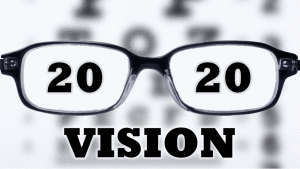If you are fortunate enough to have 20/20 vision, you can see clearly with no need for corrective measures of any kind. Up until my early twenties, I assumed I was one of those fortunate ones with normal vision, having gone without glasses or contact lenses my entire life. However, during my last semester in college, I began noticing that I was not able to read the writing on the whiteboard unless I sat in the very first row, and so I scheduled an eye exam. During the exam when I was asked to read the eye chart, I could barely see the large letter at the very top. To say it was a rude awakening was an understatement. I immediately ordered my first pair of glasses and within a few days, my world was transformed. Everything and everyone changed. Road signs, lecture talking points, facial features. Everything was not only clear but looked radically different. For years what I had seen as normal, had been completely distorted.
As we approach 2020, I am pondering my vision for the new decade. The more I ponder, the more I see how vision acuity impacts our reality. The lenses through which we view our world can potentially present us with a false reality, causing us to miss out on what is really there.
There's lots that can keep us from having clear vision, but as I reflect on 2019 and search for my "word" for 2020, there are three things that immediately come to mind:
Writing this post has helped me determine my "One Word" for 2020. My word is "PRESENT." By focusing on the present, I will stop regretting, worrying, and comparing. In doing so, my vision of reality will be more clear, enabling me to make the most of today so I can be a blessing to those I get to share life with.
Wishing you and yours a very clear and blessed 2020!
There's lots that can keep us from having clear vision, but as I reflect on 2019 and search for my "word" for 2020, there are three things that immediately come to mind:
- Regretting the past. The past has come and gone and there's nothing we can change. Dwelling on the good ole days or torturing ourselves over mistakes, will not change the past, but if we are not careful, it will change the present. Regret can potentially cripple us with insecurity and cause us to lose momentum. Conversely, building on successes and learning from failures helps us to see possibilities and help us pick up speed.
- Worrying about the future. We can't predict what will happen tomorrow, but worrying about what may or may not happen will not change a thing. Worry causes us to lose focus and keeps us from seeing all the good things happening in the present. If we take one day at a time and deal with challenges as they come, we will be more at ease and in control. You may also agree that we will usually handle things much better than we anticipate and in the end, most of what we worry about will never happen.
- Comparison. Comparing ourselves - our work, our families, our achievements - will often not only steal our joy and peace, but it can also make us either believe that we don't measure up or it can swell us up with pride. Neither is good. While healthy competition can inspire growth, comparing ourselves with others keeps us from seeing all the good that surrounds us. If you are on social media (like most of us) you can be especially vulnerable to a distorted view of reality, as most of what is published is not accurate. Let's celebrate each other's uniqueness and be grateful for what we have. In doing so, we will be able to clearly see the truth and count our blessings.
 |
| -Bill Keane |
Wishing you and yours a very clear and blessed 2020!



































